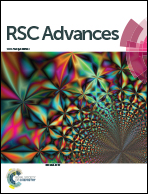Gram-grade Cr(vi) adsorption on magnetite/carbon hybrid architectures
Abstract
In this work, two-dimensional magnetite/carbon (Fe3O4@C) hybrid architectures were fabricated by a feasible template method via thermal treatment. The Fe3O4 nanoparticles were tightly embedded into the carbon sheets in the form of well-ordered arrays and disordered assembly. These architectures were then employed to remove Cr(VI) ions from water. Whatever the arrangement of Fe3O4 nanoparticles in the carbon sheets, the maximum Cr(VI) adsorption capacities were found to be around 1100 mg g−1 above 308 K in the pH range of 4.84–5.83. These values, to our knowledge, were much larger than those reported for metal-oxide adsorbents and activated carbons in the previous literature. More strikingly, these adsorbents can be easily separated from water by using a magnet. The high Cr(VI) adsorption capacities at different temperatures and easy separation are highly promising for their widespread potential applications in water treatment.


 Please wait while we load your content...
Please wait while we load your content...